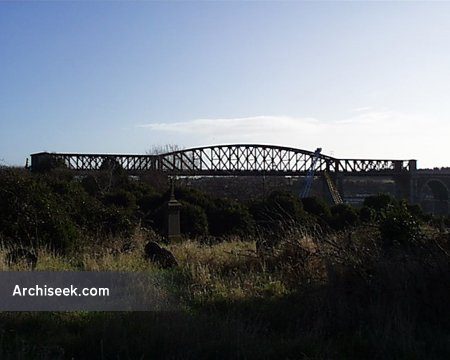1855 – Railway Viaduct, Drogheda, Co. Louth


Built between 1851 and 1855, the Drogheda Railway Viaduct is an impressive feat of engineering – equally impressive from a train as from down below. Until the Viaduct was built passengers had to disembark at Drogheda and make their own way across the Boyne to meet up with the train again at Ballymakenny some six miles outside Drogheda.
“The directors of the Dublin and Belfast Junction Railway Company have advertised for teuders for the erection of a viaduct over the river Boyne, together with other works between the temporary station at Newfoundwell and near to the terminus of the Dublin and Drogheda Railway. The total length of work to be contracted for will be about 3,950 feet. The railway will be carried over the river, at a height of 100 feet, on a lattice bridge of three bays, resting on stone piers about 15 feet wide at plinth; the centre bay is 150 feet wide, and the other two 125 feet each ; it then extends on fourteen arches, of semicircular form, each 60 feet span, and resting on piers 33 feet 6 inches by 12 feet at plinth, and 31 feet 6 inches by 8 feet 6 inches at springing, the arches to have architraves; internal spandril walls to be six in number and 15 inches thick, covered with flagging, a packing of dry rubble to be behind the abutments. The viaduct is to be set out from the wall north of the Beaulieu-road. The pier being 4 feet south of it at the top of plinth ; height to springing of arches 55 feet. The Newfoundwell viaduct consists of five arches 60 feet span, and in every respect similar to those above described. The masonry to be of limestone.” The Builder, January 4 1851.

William Evans was given the contract to build the Viaduct and was also contracted to build the Newfoundwell bridge and an embankment which he completed. In 1853 the bridge was almost complete except for two piers which were to support the iron lattice portion. The foundations for these piers bankrupted Evans as the muddy bed of the river proved to be quite deep, and the excavations went over budget costs.
“Th directors of the Dublin and Belfast Junction Railway have at length, after a deliberation of four months, decided upon the contractor for the viaduct over the river Boyne. The tender of Mr. Evans, late contractor for the Conway viaduct on the Chester and Holyhead Railway, has been accepted. The decision has given great dissatisfaction to Irish firms, whose proposals were equally disregarded, as in the case of the Dodder viaduct, lately disposed of by the Dublin and Kingstown Railway Company to an English contractor.” The Builder, July 12 1851.
James Barton took over the contract and in October 1853 the foundations were laid 43 feet under the water level. The Viaduct’s original cost of £68,000 eventually ran to £123,000. In 1932 the original iron was replaced with steel, at which time the central span was given its curved profile.












